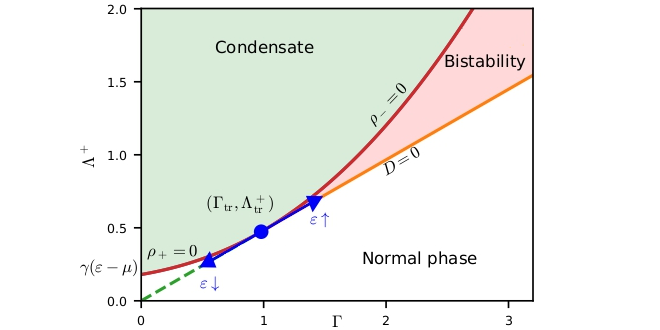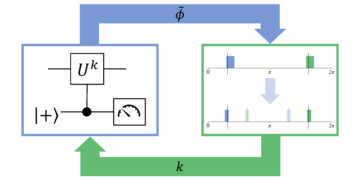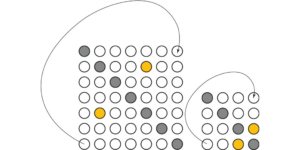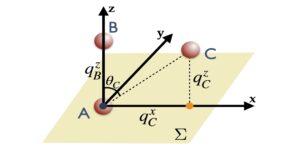1N.L. Dukhov Research Institute of Automatics (VNIIA), Moscow 127030, Russia
2Institute for Spectroscopy RAS, Troitsk 108840, Moscow, Russia
3Moscow Institute of Electronics and Mathematics, National Research University Higher School of Economics, 101000 Moscow, Russia
Find this paper interesting or want to discuss? Scite or leave a comment on SciRate.
Abstract
Bose-condensation in a system of 2D quasiparticles is considered in the scope of a microscopic model. Mean-field dynamical equations are derived with the help of the Schwinger-Keldysh formalism and a simple model is proposed which allows to describe key features of condensate formation in systems with various quasiparticle decay rates. By analysing stationary solutions of this equation, we obtain the phase diagram of quasiparticle gas, finding a bistability region in the parameter space of the system. Finally, as an application of our theory, we study the phase diagram of a 2D exciton-polariton system in CdTe microcavity.

🇺🇦 Quantum strongly condemns the 2022 invasion of Ukraine, the loss of life and war crimes inflicted by Russian forces. For more information on our policy on publishing articles by authors based in Russian institutions, see this post.
► BibTeX data
► References
[1] S. Bose, Z. Phys. 26, 178 (1924).
[2] A. Einstein, Sitz. ber. Preuss. Akad. Wiss. 1, 3-14 (1925).
[3] M.H. Anderson, J.R. Ensher, M.R. Matthews, C.E. Wieman, and E.A. Cornell, Science 269, 198201 (1995).
https://doi.org/10.1126/science.269.5221.198
[4] C.C. Bradley, C.A. Sackett, J.J. Tollett, and R.G. Hulet, Phys. Rev. Lett. 75, 1687 (1995).
https://doi.org/10.1103/PhysRevLett.75.1687
[5] K.B. Davis et al., Phys. Rev. Lett. 75, 39693973 (1995).
https://doi.org/10.1103/PhysRevLett.75.3969
[6] A. A. High, J. R. Leonard, A. T. Hammack, M. M. Fogler, L. V. Butov, A. V. Kavokin, K. L. Campman et A. C. Gossard Nature 483, 584–588 (2012).
https://doi.org/10.1038/nature10903
[7] A. A. High, J. R. Leonard, A. T. Hammack, M. M. Fogler, L. V. Butov, A. V. Kavokin, K. L. Campman et A. C. Gossard Nano Lett., 12, 5 (2012).
https://doi.org/10.1021/nl300983n
[8] J.Kasprzak et al., Nature 443, 409 (2006).
https://doi.org/10.1038/nature05131
[9] R.Balili et al., Science 316, 1007 (2007).
https://doi.org/10.1126/science.1140990
[10] S.O. Demokritov et al., Nature 443, 430 (2006).
https://doi.org/10.1038/nature05117
[11] J.Klaers, J.Schmitt, F.Verwinger, and M.Weitz, Nature 468, 545 (2010).
https://doi.org/10.1038/nature09567
[12] A. Imamoḡlu, R.J. Ram, Physics Letters A 214, 3–4, 193-198 (1996).
https://doi.org/10.1016/0375-9601(96)00175-2
[13] C. Piermarocchi, F. Tassone, V. Savona, A. Quattropani, and P. Schwendimann, Phys. Rev. B 53, 15834 (1996).
https://doi.org/10.1103/PhysRevB.53.15834
[14] P. Stenius, Physics Letters B 60, 14072 (1999).
https://doi.org/10.1103/PhysRevB.60.14072
[15] M. Wouters and I. Carusotto, Phys. Rev. Lett. 99, 140402 (2007).
https://doi.org/10.1103/PhysRevLett.99.140402
[16] J. Keeling, N. G. Berloff, Phys. Rev. Lett. 100, 250401(2008).
https://doi.org/10.1103/PhysRevLett.100.250401
[17] F. Manni, K. G. Lagoudakis et al, Phys. Rev. Lett. 107, 106401 (2011).
https://doi.org/10.1103/PhysRevLett.107.106401
[18] A. Opala, M. Pieczarka, and M. Matuszewski, Phys. Rev. B 98, 195312 (2018).
https://doi.org/10.1103/PhysRevB.98.195312
[19] L. A. Smirnov, D. A. Smirnova, E. A. Ostrovskaya, and Yu. S. Kivshar, Phys. Rev. B 89, 235310 (2014).
https://doi.org/10.1103/PhysRevB.89.235310
[20] F. Baboux, D. De Bernardis, V. Goblot, V. N. Gladilin, C. Gomez, E. Galopin, L. Le Gratiet, A. Lemaître, I. Sagnes, I. Carusotto, M. Wouters, A. Amo, and J. Bloch, Optica 5, 1163-1170 (2018).
https://doi.org/10.1364/OPTICA.5.001163
[21] L. P. Pitaevskii, Sov. Phys. JETP 35, 282 (1959).
[22] M. Wouters and I. Carusotto, Phys. Rev. Lett. 105, 020602 (2010).
https://doi.org/10.1103/PhysRevLett.105.020602
[23] H. Haug, T. D. Doan, and D. B. Tran Thoai, Phys. Rev. B 89, 155302 (2014).
https://doi.org/10.1103/PhysRevB.89.155302
[24] A. A. Elistratov and Yu. E. Lozovik, Phys. Rev. B 97, 014525 (2018).
https://doi.org/10.1103/PhysRevB.97.014525
[25] H. T. C. Stoof, Journal of Low Temperature Physics 114, 11-108 (1999).
https://doi.org/10.1023/A:1021897703053
[26] H. T. C. Stoof in: Kaiser, R., Westbrook, C., David, F. (eds), Coherent atomic matter waves. Les Houces – Ecole d’Ete de Physique Theoretique, 72, Springer, Berlin, Heidelberg (2001).
https://doi.org/10.1007/3-540-45338-5_3
[27] A.-W. de Leeuw, H. T. C. Stoof, and R. A. Duine, Phys. Rev. B 88, 033829 (2013).
https://doi.org/10.1103/PhysRevA.88.033829
[28] K. Dunnett and M. H. Szymanska, Phys. Rev. B 93, 195306 (2016).
https://doi.org/10.1103/PhysRevB.93.195306
[29] A. O. Slobodeniuk and D. M. Basko, Phys. Rev. B 94, 205423 (2016).
https://doi.org/10.1103/PhysRevB.94.205423
[30] H.T.C. Stoof, Phys. Rev. Lett. 66, 3148 (1991);Phys. Rev. A 45, 8398 (1992).
https://doi.org/10.1103/PhysRevA.45.8398
Cited by
This Paper is published in Quantum under the Creative Commons Attribution 4.0 International (CC BY 4.0) license. Copyright remains with the original copyright holders such as the authors or their institutions.
- SEO Powered Content & PR Distribution. Get Amplified Today.
- PlatoData.Network Vertical Generative Ai. Empower Yourself. Access Here.
- PlatoAiStream. Web3 Intelligence. Knowledge Amplified. Access Here.
- PlatoESG. Carbon, CleanTech, Energy, Environment, Solar, Waste Management. Access Here.
- PlatoHealth. Biotech and Clinical Trials Intelligence. Access Here.
- Source: https://quantum-journal.org/papers/q-2023-10-16-1144/
- :is
- ][p
- 1
- 10
- 100
- 11
- 12
- 13
- 14
- 15%
- 16
- 17
- 178
- 19
- 1995
- 1996
- 1999
- 20
- 2001
- 2006
- 2008
- 2011
- 2012
- 2013
- 2014
- 2016
- 2018
- 2022
- 214
- 22
- 23
- 24
- 25
- 26%
- 27
- 28
- 29
- 2D
- 30
- 35%
- 60
- 66
- 7
- 72
- 75
- 8
- 9
- 97
- 98
- a
- ABSTRACT
- access
- affiliations
- AL
- allows
- an
- Analysing
- and
- anderson
- Application
- ARE
- articles
- AS
- author
- authors
- based
- Berlin
- Break
- by
- COHERENT
- comment
- Commons
- considered
- copyright
- cornell
- Crimes
- David
- Davis
- Derived
- describe
- discuss
- e
- E&T
- Economics
- einstein
- Electronics
- equations
- Features
- field
- Finally
- finding
- For
- Forces
- formation
- GAS
- Gomez
- help
- High
- higher
- holders
- HTTPS
- i
- in
- information
- Institute
- institutions
- interesting
- International
- invasion
- JavaScript
- journal
- Key
- Leave
- leonard
- License
- Life
- loss
- Low
- mathematics
- Matter
- max-width
- mean
- model
- Month
- more
- Moscow
- nano
- National
- Nature
- obtain
- Oct
- of
- on
- open
- or
- original
- our
- pages
- Paper
- parameter
- phase
- Physics
- plato
- Plato Data Intelligence
- PlatoData
- policy
- presence
- proposed
- published
- publisher
- Publishing
- Quantum
- R
- RAM
- Rates
- references
- region
- remains
- research
- russian
- s
- School
- Science
- scope
- Simple
- Solutions
- SOV
- Space
- Spectroscopy
- strong
- strongly
- Study
- such
- system
- Systems
- The
- their
- theory
- this
- Title
- to
- Ukraine
- under
- university
- URL
- various
- volume
- want
- war
- waves
- we
- which
- with
- year
- zephyrnet











